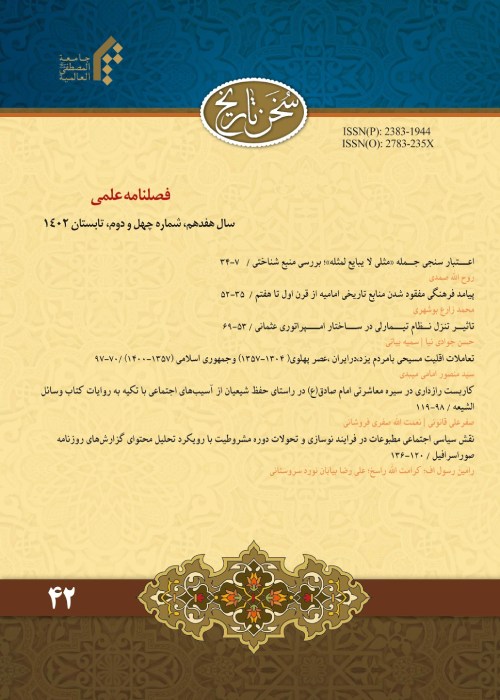A Reflection on the Meaning of Exploring Religious Iconography in the Ghadirakhm Painting by Haji Farsi Mahfouz in the Astan Museum of Masoumeh Astan
One of the examples of religious painting in the Qajar period is the Ghadirakhm painting in the Astan Museum of Hazrat Masoumeh, which is a lasting painting in the field of religious iconography and transmission of religious traditions in the Qajar period. In this painting, the emphasis on the realistic representation of the Ghadir Kham event has been one of the important roles in the magnificent display of this religious event. In this little-known painting by Haji Farsi, in the Gham Museum, numbered 900, it reveals to us the pictorial tradition of the Ghadir event along with the art of Fajjar's court iconography. The study of this work shows that the artist has tried to show the characteristics of court portraits of kings and their devotion to the Shia religion and the important event of Ghadir by realistically depicting the incident of Ghadir and linking it with Qajar court portrait painting. The main focus of the painting is on the incident of Ghadir, which is seen more than the pictures of the kings. The depiction of the incident of Ghadir has a pictorial concordance with the characteristic of court portrait painting. The purpose of this research is to study the painting of the Ghadir event, which has not been introduced and researched so far, and it deals with the characteristics of court portrait painting in the margin of the work and focusing on the Ghadir event. The main questions of the research are as follows: What are the characteristics of showing the Ghadir event in the center of the image? What was the decorative function of depicting the Qajar kings in the way of iconography on the sidelines of the Ghadir incident? The research method in this scientific research is descriptive-analytical, using library resources and a field study of a museum example of the work in Qom Museum, and the method of analysis is based on the principles and rules of visual art used in painting. The present research is one It analyzes the Ghadir event and its relationship with Qajar painting from religious and meaningful aspects. The results of the present research show that in this painting, in addition to the representation of the important event of Ghadir, in addition to the display of court iconography, the visual characteristics of the work correspond to the characteristics of Qajar court iconography painting and the devotion of the important kings of Iran from the past to the Qajar period to Shiism and Ali. It displays A.
Qajar , Painting , Iconography , Ghadirakhm , Haji Farsi
- حق عضویت دریافتی صرف حمایت از نشریات عضو و نگهداری، تکمیل و توسعه مگیران میشود.
- پرداخت حق اشتراک و دانلود مقالات اجازه بازنشر آن در سایر رسانههای چاپی و دیجیتال را به کاربر نمیدهد.



